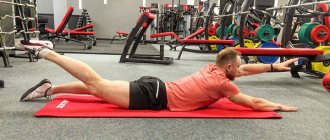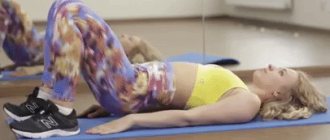≡ July 15, 2020 Category: Mind & Body
Every guy or girl who has firmly decided to learn how to do the splits (longitudinal or transverse – in this case it doesn’t matter) is probably familiar with numerous videos on YouTube where this exercise is easily and naturally performed by professionals. But can a beginner do this? And if so, how long will it take to train for this?
The answer to the first question is clear - yes, it is possible. As for the second, the correct answer to it will sound like this: it all depends on your attitude towards achieving the final result and how persistent and intense your training will be. And remember - even the prima of the Bolshoi Theater always warms up before stretching. And for beginners, warming up before stretching into splits must include a whole set of exercises. And not just any - but allowing each muscle, ligament and joint, one way or another, to warm up efficiently and effectively in the implementation of this position.
Is warming up for splits at home effective, and is it possible to do it without going to the gym? Of course - but only if all safety rules are followed, and at the same time having thoroughly studied (to begin with, at least theoretically - from articles, videos and photos) the entire step-by-step process of preparing for how to warm up the muscles before stretching the splits.
Voice training
We need to start with the basics. Let's explore voice training exercises and also get acquainted with professional tips to help improve your singing. Here they are:
1. Warm up the ligaments. This will help prevent injury. When a person sings, his vocal cords constantly vibrate. Therefore, before the process itself, you need to warm them up, just like the muscles before training. To do this, you need to inhale and exhale through your mouth for 2 minutes.
2. Drink water often. This advice is useful not only for those losing weight, but also for singers. When singing, your throat dries out faster than when talking. If you drink a lot of water, your ligaments become “lubricated”, like a mechanism in a car.
3. Take the correct posture. We think that singing is only influenced by the vocal cords. This is wrong. The diaphragm also takes part in this. To sing beautifully, you need the right posture. You need to pull your shoulders back a little, straighten your chest as much as possible, and keep your body straight. In this case, it is necessary to relax the muscles.
4. Record your voice. What is it for? When a person hears his voice in a recording, he can more easily determine what is wrong in order to identify his weak points and not repeat mistakes in the future.
5. How to train your voice for singing? Play your favorite musical compositions more often. To do this, it is better to choose one genre and not change it. This way you can practice and learn the basics of singing. In addition, this activity always lifts your spirits.
How to start breathing?
In order to establish breathing, you must first place support.
Support is the area of our body on which we lean when singing.
Breathing is used through support. For singers, it should be in the stomach. Therefore, beginning performers first need to learn to connect breathing with support.
Exercises for voice and speech development
We found out how to start learning to sing. Now let's talk about diction. To sing beautifully, you need to train your voice for speech. You can do the exercises yourself at home. The words in songs can be difficult and intricate, but you need to move from line to line smoothly, without stuttering. To learn this, you need to do the following exercises for voice training and correct beautiful speech:
- As you begin, pay attention to the position of the organs in your mouth. The tongue should not be too raised, and the lips should not be spread wide. Keep an eye on this while singing and talking.
- Practice words with repeating sounds. Try to have them at the beginning, in the middle, and at the end of words. The sounds being practiced must be paired. For example, the combinations “p-b”, “g-k”, “z-s”. You can also combine sounds with vowels, for example, “dbi-dbe-dba” or “gzi-gze-gza.”
- Practice sounds to such an extent that you pronounce them very clearly and quickly.
- Practice pronouncing tongue twisters. Forget all the ones you are already good at. Purposefully look for new ones, pronouncing them with different intonations.
These exercises for voice and speech will help you at the beginning of your creative journey
The role of muscle warming
We will tell you in detail how to properly warm up your muscles before training in today’s material. First, you should understand why warming up is really important and necessary:
- Warming up muscles involves increasing the temperature of their fibers. In this state, they work more efficiently and relax better. This helps improve strength, speed and endurance. Even warmer muscles are more elastic, so the likelihood of getting a sprain is lower.
- Vasodilation is another factor in favor of warming up before exercise. Blood flow improves, the load on the heart decreases, and the muscles receive more oxygen.
- Normal cooling of the body due to normal thermoregulation (sweating). This eliminates the risk of overheating and muscle injury at the beginning of the training process.
- Psychological aspect. By warming up before training, you are mentally prepared for intense work, so the activity will be more beneficial.
Ear for music
Why develop it? Without an ear for music, it is impossible to grasp the motive or sing the correct verse or chorus. That is why it is necessary to develop hearing. Here are some exercises that will help with this:
- You will need a musical instrument or an appropriate application on your phone. With its help, you need to reproduce: “do-re-mi-fa-sol-la-si-do”, while singing them, trying to hit the notes. Play scales from the very beginning to the end, and then in reverse order: “do-si-la-sol-fa-mi-re-do.” In one approach, this action needs to be done about 30 times in order to remember and feel each note.
- An exercise called "Echo". It is suitable not only for adults, but also for children. Listen to the song and then try to reproduce it yourself. Do it out loud. You can learn line by line. Repeat not only the words correctly, but also the motive. Don't move on to the next one until you get the previous one right. This is done in order to hit each note clearly and correctly.
- Musical notation. Learn to read notes, compare their sound with the melody of the song. Then this will help the ear for music begin to develop faster, and the reproduction of sounds will become more meaningful and understandable.
- Sing intervals. To complete this exercise you will need a musical instrument. An interval is the distance between two notes. For example, “do-re”, “do-mi”, “do-fa”, “do-sol”, “do-la”, “do-si”. Climb up the note “steps” and then go down them.
- Singing adjacent notes, for example, “do-re”, “do-si-do”.
- Studying the classics. When we strive to succeed at something, we become more interested in that subject. Interest in the classics will arise just when learning the basics of singing. It happens that a complex chord is much easier to remember if you memorize the motive in which it is contained.
Universal exercises
Increasing muscle temperature start with basic relaxation. To do this, take the initial position – feet shoulder-width apart. Raise your arms as you take a deep breath and lower them as you exhale. And so 4-5 approaches.
Next, decide which muscle group is most loaded when stretching. These parts of the body should be the main focus when warming up. For any type of physical activity, there are such universal movements as neck rotation, shoulder warm-up, and torso rotations. To warm up the lower part, walk at a slow pace, squats, swing your legs, and jump rope. Bends forward give elasticity not only to the back muscles, but also to the vertebrae. A light jog is very effective. You can do it either on a treadmill in the gym or in the fresh air, which is healthier for the body. The calf muscles will become warmer as you lift your legs.
Stretching exercises can also serve as warm-up exercises. Raising your arms up, clasp your palm around the wrist of your other hand. Lean slowly to the left. Return to the original position and repeat, but in the opposite direction.
To warm up your lower muscles, lunge with one leg while resting on the knee of the other. Using your hands, gently pull the heel of the same foot towards your buttock.
Lying on your back, lift your legs up at a right angle. Grasping your ankles with your hands, pull your legs towards your head, pulling your toes towards you. At the same time, do not lift your lower back off the floor.
The final exercises can be exercises with a skipping rope. If you don’t have one at hand, replace it with jumping on the spot.
So, regardless of whether you need stretching for professional victories, moral and physical satisfaction from body flexibility, or to benefit your body, you can achieve maximum results without associated injuries only by properly warming up the entire muscle group before stretching.
Beautiful voice
How to train your voice? This question is often asked by those who want to learn to sing on their own. Once you have learned to speak clearly and quickly, you should move on to singing exercises. At the same time, the voice itself will become lower, the range will expand, and the pronunciation will improve several times. The main thing is that before starting exercises to develop your voice, record how it sounds in the first lesson, and after several weeks of training, compare it with what it sounds like. You need to do the following:
- Stand in front of the mirror and begin to pronounce vowel sounds in the sequence “ee-a-a-o-u”, stretching out each of them until you can’t breathe. Why this particular sequence? The fact is that this exercise begins with the sound “i”, which has the highest frequency. All other sounds follow as this indicator decreases. Each sound has a unique feature. For example, “and” when stretching will cause you to feel a slight vibration of the skin when you put your hands on your head.
- Now activate your diaphragm by making the sound “m” with your mouth closed three times a day. At the same time, it must be pulled out as if it were a vowel (“mm-mm-mm”). Pronounce the sound quietly the first time, then a little louder, and then very loudly, so that the vocal cords tense. If after exercise the next day they hurt, then next time you need to pronounce the sounds less loudly, reducing the range of sound.
- The sound “r” gives the voice an assertive sound, energy and strength. Prepare for the exercise by raising the tip of your tongue to the roof of your mouth and making the “r” sound. You should get some kind of growl. After this, begin to pronounce this sound expressively and with different intonations in the words “role”, “steering wheel”, “ruble”, “ring”, “snout”, “risk”, “lynx”, “rhythm”, “product”, “ cheese", "cook", "frost". Use words in which the sound is in different parts of the word and is also repeated, for example, “terrace”.
- Exercise "Tarzan". You must do it without fail if you are interested in how to train your voice. It is an effective completion of the tasks we described above. You need to do exercise number 1, making sounds in the same sequence, but at the same time you need to hit yourself on the chest with your fists (just not too hard, so as not to harm yourself).
All exercises will give a more effective effect if performed in the morning. In addition, you will be charged with positive energy for the whole day, and your breathing will be easy.
Main types of exercises
Warm-up before training your legs, arms, abdomen and back includes extremely simple exercises - various rotations, twisting, squats, bending, push-ups. A good way to warm up quickly and effectively is to run. You need to start with a leisurely walk, then increase the pace, and in the last 7-10 minutes of warming up, start running at an average speed. You will use the maximum amount of muscle tissue, make your heart work faster, and speed up blood circulation. After such a warm-up before training at home, the body will be ready for a more serious load.
General warm-up
Warm-up exercises before training can be combined into the following groups:
- Universal. Relevant before any physical activity. Such complexes are carried out in school physical education lessons, so everyone knows them. The warm-up begins with turns and tilts of the head, then you need to move on to working out the shoulder girdle, arms, torso, hips, knees, and ankles. The final stage of preparation is breathing exercises.
- Special. The main difference before the universal program is the maximum warming up of the muscles that will work intensively during training. If this is a power load, tasks from the main complex are performed, but without weights.
At home, you can warm up like this: jumping rope, walking at a fast pace with your knees high, going up and down the stairs. If you're going to train your abs, spin a hula hoop. Before a long run, it is important to do one set of lunges, squats, push-ups, and bends. Stretch your thigh and calf muscles, and be sure to rotate your knee joints and ankles.
Joint warm-up
This type of training helps to activate joints, tendons and ligaments, improves their mobility, coordination, and works the periarticular muscles. Often the complex acts as a full-fledged workout, it is so effective. It should be performed at home before strength training, fitness, yoga, or cardio exercise. What exercises to warm up the muscles before training are included in this complex? Examples:
- Tilt your head back and forth, left and right. Head rotation.
- Lateral tilts of the body.
- Stretch your arms up and to the sides.
- Rotations of the shoulders, forearms, hands, chest.
- Twisting the body, rotating the pelvis, turning the legs.
- Lifting, bending-extension of legs at the knees.
- Ankle rotations.
- Calf raises.
Stretching before exercise
Harmonious weight loss and improvement of body shape at home is only possible with the implementation of a comprehensive program. Stretching is not the last place in this matter. It is often recommended to do it after a sports activity, but this type of activity is also good as a warm-up before training at home. For exercises to produce results, they must be performed with a certain amplitude. If muscle tissue is poorly warmed up and stretched, there is a high probability of injury.
Before stretching, you need to perform a small set of warm-up movements. Everything needs to be done smoothly, pain should not be allowed. The feeling should be comfortable. After proper stretching, a pleasant warmth spreads throughout the body and you do not feel tired. If you want to do the splits, make this the goal of your main workout or cool-down. When your muscles become “hot”, perform dynamic stretching exercises:
- Take the tasks from the general warm-up as a basis. When performing them at home, stay longer at the highest point and try to stretch the muscle tissue as much as possible.
- If necessary, help yourself with your hands, but without effort or jerking.
- Sometimes at home it is difficult to adequately assess your progress and body position, so if possible, look in the mirror. This will allow you to see the main errors.
- Effective warm-up exercises for women and men - swings, rotations with legs, arms, spring lunges (can be dangerous for beginners!). Start moving in a small amplitude and gradually increase the angle of elevation.
How to increase your vocal range
This indicator changes for each person throughout his life. It is possible to expand it until the age of 9, but it is useless, since children are just developing their vocal cords. After 10-12 years, you can start exercising, because at this age the chest expands and the voice becomes more mature. You may have noticed this in your children or remember it happening to you yourself. How to train your voice to increase its range? To do this, you can use the following exercises:
- Start with a simple chant. Please note that each person has his own primary zone. This is the range in which he is comfortable singing and speaking. Start chanting from this zone. Your singing should be light and free, without tension. Breathing should be taken after moving to each link. Work your way up gradually to the highest notes and then start moving down. Make sure your voice is natural. Notice how it changes in different parts of the chant, after which notes does it become completely different? Notice when the voice goes over the chest. Are you comfortable singing in this tessitura? If so, then this is the lowest part of your range.
- How to train a beautiful voice? Choose a chant in the octave range and sing it only on vowel sounds, for example, on the syllables “la”, “yu”, “mu”. It is in the upper notes that this chant will help expand the range.
- You can choose a song with big jumps and a wide range, like “Ave Maria.” Start in a tessitura that is comfortable for you. This will also help expand it. In addition, you will learn the limits of your capabilities.
- Sing in one manner, but at the same time make leaps from top to bottom by sixth. It may be difficult at first, but after a few weeks of hard work, everything will work out.
These tips will help to significantly expand the range of your voice, and you will be able to sing any composition beautifully.
What are the dangers of not warming up?
Many beginners make the same mistake when they come to the gym: they start doing exercises with heavy weights. For example, they do a bench press with a weight of 60-80 kg at once with a working weight of 100 kg. This is simply unacceptable, as the chance of injury is too high:
- sprain is the most common situation;
- fainting due to a sharp increase in blood pressure;
- joint damage.
Experienced athletes always begin their workout with a warm-up to warm up the entire body. Some even do the splits and perform other complex exercises to stretch ligaments and muscle fibers, while for beginners it is enough to limit themselves to the complex described above.
How to learn to speak beautifully
Now let's turn your attention to the main voice. It, like singing, also needs to be trained. There are special exercises for this. They will help you understand how to train your voice to speak beautifully. You need to do the following:
- Find a random tongue twister on the Internet and say it so that only the consonants are heard. Do the same with vowels. They should be drawn out, but at the same time dull.
- Say the same tongue twister, but now in a completely different tone, intonation and voice. Listen to your words. Try to determine the epicenter of your own voice, to understand in what tone it sounds more natural. Do the exercise again, but adding, for example, tilting your head in any direction.
- Read the tongue twister, placing your tongue on your lips, changing the pronunciation of vowels.
- Try reading some text in one breath. Exhale. Next, inhale through your nose in the passages where you need to pause.
After these exercises, read the text in a normal voice. Try to feel the difference before and after exercise.
Exercise technique
The number one rule in stretching is to be sedate and relaxed, it is very difficult to pull a tense muscle.
The second thing to consider is posture. You should always have a straight back. Even if you are curled up and it seems impossible to straighten your back, stretch, try to keep your back straight. By hunching over, you reduce the elasticity of your muscles and ligaments.
Third, avoid positions that cause injury. For example, if you are bending down, trying to touch the floor with your hands, then keep your knees straight, but when straightening, bend them slightly at the knees.
Also don't forget about breathing. Breathe evenly, do not hold your breath. Inhale through your nose and exhale through your mouth.
Take care of the symmetry of the stretch - after doing the exercise on your right leg, repeat it on your left.
And most importantly, be sure to do warm-up exercises for at least 10 minutes before stretching. This can be active walking, running, cycling, jumping.
This way you will improve your results when stretching, because warmed muscles are elastic muscles.
Moreover, this will prevent you from injury due to unsuccessful sudden movements while performing stretching.
Advice from professionals
One singer was asked how he achieved such a beautiful sound in his voice. “How did I train my quiet and slurred voice?” - he asked again and talked about the exercises that helped him with this. It turns out that you need to do this:
- the essence of this exercise is to open your mouth and begin to move your jaw in different directions;
- lean in any direction, pronouncing vowel sounds and stretching them out, then rise carefully and smoothly, then start leaning again, but in the other direction;
- to stretch your tongue, move it quickly for about 3 minutes, but it should not protrude from your mouth;
- open your mouth, stick out your tongue, then lift its tip and touch each tooth.
Reade set Go!
Having received all the necessary theoretical information, let’s move on to practical recommendations on how to warm up before stretching and how to make this task easier for yourself.
Step #1. Good music selection. Ideally, it is better to mix it at different paces - more invigorating for the initial, quick exercises, and calmer - when the main exercises for stretching are done. Choose styles to suit your taste - from pop to Progressive House, or just take ready-made fitness selections specially written for stretching.
What to do if your speech is slurred
A slight speech impediment can be observed in people who have problems with the articulatory apparatus. Pathologies can be congenital or acquired. They cause people to swallow individual sounds and entire syllables during conversations, making them difficult to understand. In many cases, the defect can be eliminated with the help of special exercises:
- say long words with many vowels several times a day;
- recite poems out loud. At the same time, watch the rhythm.
These exercises will help correct slurred speech, and others will begin to understand you.
Level of muscle plasticity
From a physiological point of view, there are three types of muscle corset flexibility.
- The first belongs to those lucky few who have been endowed with incredible plasticity by nature itself. They are the ones who show the wonders of plasticity in circuses and at various shows, literally curling into a ring and calmly devouring a cake with a spoon clutched in the toes of a leg thrown over the head.
- The second type of flexibility is not innate, but acquired. It characterizes people who professionally know how to warm and stretch muscles to the maximum possible limit for the body - primarily yogis, as well as ballerinas, acrobats, gymnasts, dancers and representatives of some other similar professions. Most of us belong to this type.
- And only the third type - the so-called “wooden guys” - are practically unable to develop such skills due to congenital problems with the musculoskeletal system. Although they can achieve certain success with regular home exercises.
How to Improve Speech Clarity
If during a conversation you often have to repeat the same words, and the interlocutor does not understand you, then we can conclude that your speech is unclear. This needs to be fixed. Here are exercises that will help you:
- You can't rush during a conversation. Control your breathing. When you take a breath, start speaking. Exhale slowly while doing this. Then breathing will occur in unison with speech. This will cause you to take your time.
- Take your time when speaking. During public speaking, many people speak quickly and haltingly. To prevent this from happening, take a short break and calm down. Then continue the conversation.
- Swallow excess saliva in your mouth. Its remnants prevent us from pronouncing the letters “k” and “s”. It is important to remember that you should not swallow saliva in the middle of a sentence, as it will come out unsaid.
- Think about everything you want to say. Clearly spoken words are as important as the message you want to convey to people.
- Rehearse. If you have to give a speech, anxiety may prevent you from saying what you intended. You may also begin to speak confusingly, jumping from one topic to another. Rehearsing will help you overcome these difficulties.
- Repeat those words that seem difficult to you. Learn to pronounce them correctly. Then you won’t have an “accidental” reservation in the company.
Why you need to warm up your whole body before stretching
With the help of a warm-up, you can not only physically prepare for stretching, but also get your mind ready for work. The stretching effect is more pronounced on warmed muscles. They are more mobile, in good shape and ready for increased stress.
The basic warm-up consists of a light cardio load and joint exercises: head rotations, large and small joints, light stretching of the main muscle groups. Such warm-up exercises significantly reduce the risk of injury. Warm-up helps warm up the muscles of the body that are at rest, joints and activates blood circulation.
A good warm-up = high training results + quick results from stretching. By combining the elements of physical activity, the body will acquire the desired shape, the muscles will tighten, the figure will become slimmer and more attractive.
Common mistakes
When learning to sing at home, people often make the following mistakes:
- They try to repeat the performance of the song in the same way as famous singers do. There is no need to do this, you are not parodists. Above we looked at how to train a beautiful voice. Expand its range, perfect your ear for music. However, sing in your own voice.
- Classes are conducted on a case-by-case basis. This problem occurs frequently. If you study one day a week for 3 hours, you will not achieve significant success. If you practice 5 times a week for an hour, the results will be much better.
- Psychological constraint. You won't succeed if you always think you're doing something wrong.
How to warm up in the gym?
If you work out in the gym, it is better to warm up your muscles before stretching or splits with the help of cardio exercises. Use a treadmill, orbitrack or exercise bike - 10 minutes is enough, starting at a slow pace and gradually speeding it up.
In gyms there are jump ropes and expanders, which can also be used to warm up muscles, moderately increasing the load. It is also recommended to prepare muscle fibers before each exercise by performing several warm-up approaches with light weights.
What Stretching Can Do
Increase flexibility
Stretching increases The effect of time and frequency of static stretch on flexibility of the hamstring muscles, The Relation Between Stretching Typology and Stretching Duration: The Effects on Range of Motion, Regular hamstring stretching increased range of motion joint range of motion: helps to sit lower, bend over no longer experience pain or discomfort.
However, after stretching, skeletal muscles do not change. Increasing Muscle Extensibility: A Matter of Increasing Length or Modifying Sensation? its length - it is enough for any movements, your body just doesn’t know about it. The range of motion increases due to neural adaptation: the body gets used to new conditions, considers them safe and begins to move in a new way.
In everyday life, we rarely need a large range of movement. A full fold, splits, bridges - all this will look good on Instagram, but will not be useful at all in life.
For those involved in sports and fitness, the issue of flexibility is more important, but again, splits are not required everywhere. Except in gymnastics and martial arts.
If you can lower yourself into a deep squat without bending your back or lifting your heels off the floor, and you have enough hip mobility, then there is simply no need to sit in “books” and “frogs” for a long time.
Work on mobility limitations, if any. But stop stretching something that is already stretched and moving well.
Flexibility Training and Functional Ability in Older Adults: A Systematic Review cannot recommend stretching even for older adults, even though their range of motion naturally decreases.
Unlike strength training and balance exercises, there is no direct evidence that stretching improves a person's functionality.
Correct your posture
The body adapts perfectly to any conditions, and the modern lifestyle leaves its mark on it.
We constantly maintain a sitting position with our head lowered and forward, our back bent, and our shoulders skewed. Muscles and connective tissue adapt to it, and as a result, posture is disrupted and pain in the back and neck occurs.
Stretching helps combat incorrect shoulder blade position Effectiveness of strengthening and stretching exercises for the postural correction of abducted scapulae: a review, rounded shoulders Changes in rounded shoulder posture and forward head posture according to exercise methods and incorrect head position.
In addition, it helps reduce chronic neck pain Stretching exercises vs manual therapy in treatment of chronic neck pain: a randomized, controlled cross-over trial and lower back A randomized trial comparing yoga, stretching, and a self-care book for chronic low back pain.
Bring pleasure
This is one of the reasons that cannot be refuted. Stretching is a pleasant ritual that makes you feel better. It slightly increases the Influence of Passive Stretch on Muscle Blood Flow, Oxygenation and Central Cardiovascular Responses in Young Healthy Males circulation without making you sweat or out of breath - a great option to start the day or take a break while working.
So continue to stretch when you feel comfortable and enjoy doing so.











